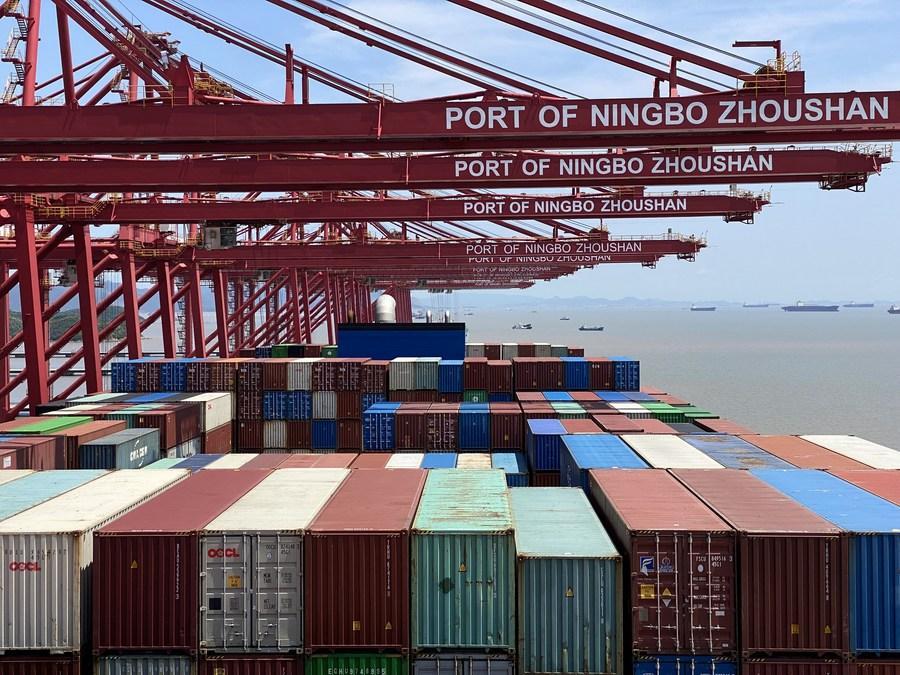


Xinhua | October 10, 2023
In late September, the Cosco Shipping Virgo, a 20,000-TEU ultra-large container ship, once again returned to the Port of Hamburg, the largest port in Germany and the third largest in Europe.
This impressive vessel, measuring 399.8 meters in length and 58.6 meters in width, embarked on its journey from China's Tianjin Port on Aug. 12. Before arriving in Hamburg, it made stops at various ports, including Dalian, Shanghai, Ningbo, Singapore, Piraeus, and Rotterdam. Right now, it is heading back to Shanghai.

The container ship Cosco Shipping Virgo calls at Meishan port area of Ningbo Zhoushan Port in east China's Zhejiang Province, Aug. 21, 2023. (Xinhua/Wei Yijun)
In command of this colossal ship is Captain Mo Weidong, a seasoned mariner with over three decades of shipping experience. It is Mo's fifth year sailing on this specific route.
"Having sailed back and forth on the route between China and Europe, I have indeed witnessed the transformative effects of the Belt and Road Initiative (BRI)," the 54-year-old captain told Xinhua reporters, as the ship called at Ningbo Zhoushan Port.
From the vantage point of the ship's bridge, perched dozens of meters above the deck, a bustling scene unfolds at the port. Containers are being impeccably stacked in precise rows by the gantry cranes used adeptly to handle them, ensuring an efficient and seamless workflow.
"Since the beginning of this year, we've seen a notable increase in cargo volumes on this shipping route," said Mo, while adding that there has been a surge in the exports of electric vehicles, lithium-ion batteries, and solar cells.

Captain Mo Weidong operates the radar at the bridge of the container ship Cosco Shipping Virgo on its way to Rotterdam Port, in the Mediterranean Sea, Sept. 15, 2023. (Xinhua)
Mo also revealed that aircraft parts will now be shipped weekly from the Port of Hamburg to the Tianjin Port via this route, further attesting to the thriving trade and economic exchanges between China and Europe.
At present, the Port of Hamburg is directly connected to major Chinese ports via 15 regularly scheduled liner services. Approximately one-third of the containers processed at the Port of Hamburg either originate from China or are bound for China.
Jens Meier, CEO of Hamburg Port Authority, underscored the significance of cooperation between the Port of Hamburg and Chinese ports. "We are actively sharing knowledge and strengthening the corridors, particularly in maritime supply chains, as well as land-based corridors," Meier explained.

A container ship of China's COSCO Shipping calls at the Port of Hamburg in Germany, Aug. 12, 2023. (Xinhua/Ren Pengfei)
In late August, the COSCO Shengshi, a ship used to carry vehicles, arrived at Germany's Port of Bremerhaven, where it unloaded 530 commercial vehicles from China, marking the successful maiden voyage of the liner.
On its way to Bremerhaven, a total of 3,731 Chinese-made commercial vehicles, including over 2,700 new energy vehicles, were loaded onto the ship at the ports of Shanghai and Xiamen.
Following its departure from Xiamen, the COSCO Shengshi navigated across the Indian Ocean and passed through the Suez Canal, making stops at ports in the UK and Belgium before finally reaching Germany. This 43-day journey spanned approximately 9,900 nautical miles.
Despite the challenges posed by the COVID-19 pandemic over the past few years, the flow of trade between China and Europe has demonstrated remarkable resilience. Mo observed an increase in trade volume, noting that it now takes two days to unload at Piraeus Port in Greece, compared to one and a half days previously.

This aerial photo taken on Feb. 19, 2022 shows a terminal of Piraeus Port in Greece. (Piraeus Container Terminal S.A./Handout via Xinhua)
In 2022, China and the EU, who are each other's second-largest trading partners, achieved record bilateral trade flows of 847.3 billion U.S. dollars, marking a year-on-year increase of 2.4 percent. This equates to over 1.6 million U.S. dollars worth of trade conducted on average every minute. Simultaneously, the two-way cumulative stock of direct investment had exceeded 230 billion U.S. dollars by the end of 2022.
BRI cooperation has significantly enhanced maritime connectivity, fostering flourishing China-EU trade and economic partnership. COSCO Shipping, for instance, now operates 181 container liner routes and allocates over 50 percent of its container capacity to BRI partner countries. The company has also invested in 57 ports within these nations.
In 2016, COSCO Shipping acquired a 67-percent stake in Piraeus Port and took over the port's management and operation. In May 2023, COSCO Shipping Ports, the company's ports operator, acquired a nearly 25 percent stake in one of Hamburg's terminals.
With the investment from China, Piraeus Port has become a leading European port. Data from the port revealed that in the fiscal year of 2022, its profit after tax had stood at 52.9 million euros, achieving a remarkable 43.9 percent increase from the previous year.

This photo taken on Aug. 21, 2023 shows containers loaded on the container ship Cosco Shipping Virgo at Meishan port area of Ningbo Zhoushan Port in east China's Zhejiang Province. (Xinhua/Wei Yijun)
At Ningbo Zhoushan Port, situated some 12,000 km from Piraeus, crane operators efficiently controlled busy gantry cranes from an operation room located 3 km away.
Drawing from his decades of experience in the shipping industry, Mo highlighted that continuous infrastructure upgrades at Chinese ports have significantly improved their operational efficiency, providing solid support for the smooth flow of global trade.
"I am expecting the BRI will bolster cooperation among countries and deliver more benefits to their peoples," Mo said.
